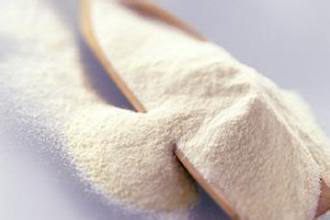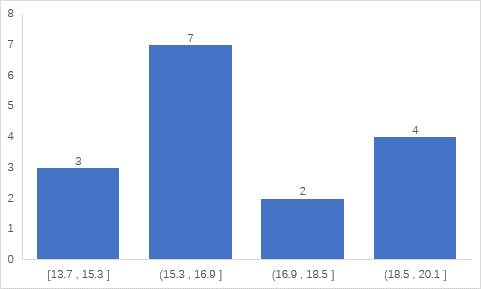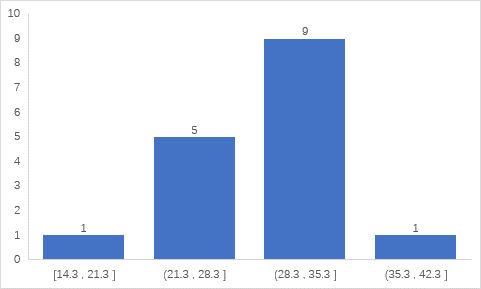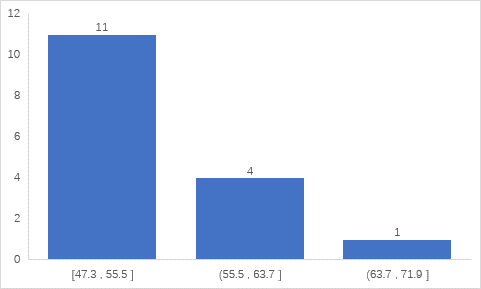
To help enterprises better understand the characteristics of nutritionally complete food for special medical purposes (FSMP) for people aged 1-10 years or above, this article has analyzed registered nutritionally complete food from several aspects, including the energy density, the energy supply ratio of the three macronutrients and their major sources.
As of September 2022, a total of 21 nutritionally complete foods for people over the age of one have been registered. Among them, five are suitable for people aged 1-10, and 16 are suitable for people over ten years old. The energy density and the energy supply ratio of the three macronutrients are shown in table 1 below.
Table 1 Summary of energy density and energy supply ratio of three major nutrients of 21 nutritionally complete foods
Serial number | Product | energy density a/kcal/mL | Energy supply ratiob /% | ||||||
|---|---|---|---|---|---|---|---|---|---|
protein | carbohydrate | Fat | |||||||
fat | linoleic acid | α-linolenic acid | |||||||
1-10 years of age | |||||||||
1 | 小安素® nutritionally complete food | 0.8 | 13.3 | 52.6 | 32.8 | 7.9 | 0.7 | ||
2 | 小佰太能nutritionally complete food | 1.0 | 11.9 | 54.7 | 33.2 | 3.8 | 0.5 | ||
3 | 小佳膳nutritionally complete food | 1.0 | 12.3 | 52.6 | 34.7 | 4.2 | 0.8 | ||
4 | 爱优诺优益力nutritionally complete food | 0.7 | 16.0 | 47.2 | 34.9 | 3.0 | 0.6 | ||
5 | 麦孚乐贝® nutritionally complete food | 1.0 | 12.4 | 52.1 | 34.6 | 4.0 | 0.7 | ||
over ten years of age | |||||||||
1 | 佳膳佳立畅nutritionally complete food | 1.2 | 13.7 | 58.3 | 25.4 | 3.3 | 0.6 | ||
2 | 伊利®欣活® nutritionally complete food | 1.0 | 16.3 | 51.2 | 29.2 | 4.2 | 0.6 | ||
3 | 全安素® nutritionally complete food | 1.0 | 15.0 | 54.2 | 28.8 | 5.1 | 0.6 | ||
4 | 佳膳悠选nutritionally complete food | 1.0 | 16.4 | 47.3 | 33.8 | 4.8 | 0.9 | ||
5 | 力存优太nutritionally complete food | 1.0 | 14.7 | 71.0 | 14.3 | 2.8 | 0.6 | ||
6 | 优博启瑞nutritionally complete food | 1.0 | 16.7 | 55.7 | 28.3 | 4.4 | 0.6 | ||
7 | 麦孚畅清® nutritionally complete food | 1.0 | 18.7 | 54.8 | 26.5 | 4.3 | 0.6 | ||
8 | 爱优诺优康力nutritionally complete food | 0.8 | 16.7 | 51.0 | 30.4 | 2.8 | 0.6 | ||
9 | 唯卡能® nutritionally complete food | 1.0 | 15.5 | 53.9 | 29.2 | 6.6 | 1.3 | ||
10 | 君蓓全nutritionally complete food | 1.0 | 16.9 | 57.3 | 25.8 | 7.2 | 1.3 | ||
11 | 希瑞臻nutritionally complete food | 1.4 | 20.1 | 50.0 | 29.7 | 4.9 | 1.1 | ||
12 | 唯源素® nutritionally complete food | 1.0 | 18.2 | 54.5 | 39.5 | 6.2 | 1.0 | ||
13 | 希瑞怡® nutritionally complete food | 1.2 | 19.9 | 48.1 | 29.9 | 5.2 | 1.1 | ||
14 | 麦孚康全® nutritionally complete food | 1.0 | 18.0 | 51.2 | 27.4 | 6.8 | 0.8 | ||
15 | 拜妥优nutritionally complete food | 1.0 | 19.4 | 48.8 | 30.1 | 4.1 | 0.7 | ||
16 | 特爱启瑞nutritionally complete food | 1.0 | 16.7 | 55.7 | 28.3 | 4.4 | 0.6 | ||
1. The energy density is calculated and rounded off with reference to the instructions on the product label.
2. The energy supply ratio of the three major nutrients is calculated and rounded off with reference to the 100mL label in the product label instruction.
1. Energy density analysis
In the nutritional treatment for special populations, energy supply is the top priority. Only after the energy supply is met, the supplemented protein can be fully utilized, and thus the nitrogen balance is improved. The Clinical Pharmaceutical Consensus on Enteral Nutrition (Second Edition) [1] points out that the energy density of commonly used enteral nutrition preparations in clinic practice ranges from 0.9 kcal/mL, 1 kcal/mL, 1.3 kcal/mL to 1.5 kcal/mL.
People aged 1-10
According to the requirements on nutrient density in GB 29922, the energy density of nutritionally complete foods suitable for people aged 1-10 shall not be less than 0.6 kcal/mL. Among all the five products registered for people aged 1-10, the energy density varies from 0.8 kcal/mL to 1 kcal/mL. The energy density span of the nutritionally complete foods for people aged 1-10 is relatively small, basically at 1 kcal/mL.
People over ten years old
According to the requirements on nutrient density in GB 29922, the energy density of nutritionally complete foods suitable for people over ten years old must not be less than 0.7 kcal/mL. According to the statistics in Figure 1, the energy density of nutritionally complete foods for people over ten years old is mainly concentrated between 0.8 and 1.0 kcal/mL (accounting for 81%). The energy density span of the 16 products is large, with the minimum being 0.8 kcal/mL and the maximum of 1.4 kcal/mL. Products with different energy densities can fulfill the needs of different individuals, providing more options for doctors or clinical nutritionists.

Figure 1 Distribution of energy density of nutritionally complete foods for people over ten
2. Analysis of three major energy-supplying nutrients
Nutritionally complete food can be used as a single source of nutrition and satisfy the nutritional needs of the target population. Protein, fat, and carbohydrates are the three major energy-supplying nutrients indispensable for the human body.
People aged 1-10
Based on the recommended amounts of Chinese residents’ dietary nutrient reference intakes (DRIs, 2013 edition), the ratio of carbohydrates for people aged 1-10 is about 50%-65%, the ratio of protein energy is about 12%-15%, and the ratio of fat energy is about 25%-35%.
DRIs subdivide the population of 1-10-year-olds into three categories: 1-3 years old, 4-6 years old, and 7-10 years old. The energy supply ratio of each cateogry is different. The younger the age is, the larger the proportion of protein and fat energy supply is, and the smaller the carbohydrate energy supply is. As people get older, the proportion of the three major nutrients gradually approaches the recommended amount for adults.
Protein:
People aged 1-10 are at the peak period of growth and development and have a high demand for protein. GB 29922 stipulates that the protein content in nutritionally complete foods for people aged 1-10 should not be less than 0.5g/100kJ, (protein energy ratio of ≥8.5%). Among the five registered products for the population aged 1-10, the protein energy ratio ranges from 11.9% to 16%.
Fat:
The fat energy ratio of the five registered products is within the recommended range of DRIs, with the minimum value of 32.8% and the maximum value of 34.9%. The variation range is relatively small. The concentration of fat is high because low-age groups have a high demand for fat.
1) Linoleic acid
Linoleic acid is an essential fatty acid for the human body. According to GB 29922, the energy ratio of linoleic acid for nutritionally complete foods for people aged 1-10 years should not be less than 2.5%. Among the five registered products for populations aged 1-10, the rate of linoleic acid in total energy ranges from 3.0% to 7.9%.
2) α-linolenic acid
α-linolenic acid is an essential fatty acid for the human body. According to GB 29922, the ratio of α-linoleic acid in nutritionally complete foods for people aged 1 to 10 years should not be less than 0.4%. Among the five registered products for populations aged 1-10, the rate of α-linolenic acid in total energy ranges from 0.5% to 0.8%.
Carbohydrate:
Among the five products, the minimum ratio of carbohydrate energy is 47.2%, and the maximum is 54.7%. Those whose rate of carbohydrate in total energy is less than 50% may consider more about the dietary needs of the lower age groups, for they need more protein and fat.
People over ten years old
According to the Chinese Dietary Reference Intakes (2013 version), the recommended ratio of carbohydrate, protein, and fat in total energy for adults (populations aged 10-17 included) is 50%-65%, 10%-15% and 20%-30%, respectively. The smaller the age is, the higher the protein and fat will be.
Protein:
According to GB 29922, the content of protein in nutritionally complete foods for people over the age of ten should not be less than 0.7g/100kJ (the rate of protein in total energy shall be 11.9%). The recommended protein rate according to DRIs is 10%-15%. Different individuals have different requirements for protein depending on their storage and metabolism. As shown in Figure 2, among the 16 registered products for populations over ten years of age, the minimum protein rate in total energy is 13.7%, and the maximum is 20.1%. The protein energy ratio of 13 products is more than 15%, indicating that the rate of protein in total energy for nutritionally complete foods for people over the age of ten is higher.

Figure 2 Analysis of protein energy ratio in products for populations aged over ten
Fat:
Fat being a major energy source, is an important component of human cells. The recommended energy ratio of fat for adults according to DRIs is 20%-30%. Studies show that in balanced standard formulations, the energy supply of fat accounts for about 27-35% of total energy [3]. Among the 16 registered products, the minimum ratio of fat is 14.3%, and the maximum is 39.5%. See Figure 3 for more details.

Figure 3 Analysis of fat energy ratio in products for populations aged over ten
Linoleic acid
According to GB 29922, the energy supply ratio of linoleic acid in nutritionally complete foods for people over the age of ten should not be less than 2.0%. Among the 16 registered products, the minimum energy supply ratio of linoleic acid is 2.8%, and the maximum is 7.2%. It can be seen in Figure 4 that the range of energy supply ratio ranges from 2.8% to 4.7%.

Figure 4 Analysis of linoleic acid energy supply ratio in products for populations aged over ten
α- Linolenic acid
According to GB 29922, the energy supply ratio of α- linolenic acid in nutritionally complete foods for people over the age of ten should not be less than 0.5%. Among the 16 registered products, the minimum energy supply ratio of α- linolenic acid is 0.6%, and the maximum is 1.3%. Figure 5 shows that the range of energy supply ratio is mainly 0.6%-1.0%.

Figure 5 Analysis of α- Linoleic acid energy supply ratio in products for populations aged over ten
Carbohydrates:
GB 29922 has no regulations on the energy supply ratio of carbohydrates in nutritionally complete foods for people over the age of ten. The recommended energy supply ratio in DRIs is 50%-65%. Among the 16 registered products, the minimum energy supply ratio of carbohydrates is 47.3%, and the maximum is 71.0%. As shown in Figure 6, the range of energy supply ratio is mainly 47.3%-55.5%.

Figure 6 Analysis of carbohydrate energy supply ratio in products for populations aged over 10
3. The sources of three energy nutrients
Carbohydrates:
The main sources of carbohydrates in these 21 products are maltodextrin, white granulated sugar, and glucose syrup. Among them, 20 products use maltodextrin which is widely used because of its absorbability and good processing characteristics. White granulated sugar is also used frequently since it can provide energy and improve the product's taste. As for dietary fiber, 10 products use FOS as the source.
Protein:
The main sources of protein in these 21 products are high-quality protein, such as soy protein isolate powder, whey protein powder, whey protein powder concentrate, and caseinate. For plant proteins, soy protein isolate is the raw material with the highest usage frequency. For animal proteins, dairy proteins are the same source of the 21 products, mainly including caseinate, whey protein, and whey protein concentrate.
Fat:
The main sources of fat in these 21 products are plant oil and MCT. And the top three are sunflower seed oil, (low erucic acid) rapeseed oil, and MCT, with 19, 18, and 10 respectively.
Please see table 2 for details.
Table 2. The main sources of three energy nutrients
Energy nutrients | Raw materials | Product quantity | |
Total carbohydrate | Carbohydrate | Maltodextrin | 20 |
White granulated sugar | 10 | ||
Glucose syrup | 7 | ||
Starch sugar | 6 | ||
Other raw materials: crystalline fructose, polydextrose, starch. | |||
Dietary fiber | FOS | 10 | |
Inulin | 4 | ||
Other raw materials: GOS, resistant dextrin. | |||
Protein | Caseinate (sodium caseinate, calcium caseinate, potassium caseinate, etc.) | 9 | |
Soy protein isolate | 8 | ||
Whey protein powder | 7 | ||
Whey protein powder concentrate | 6 | ||
Milk protein concentrate | 5 | ||
Casein | 4 | ||
Other raw materials: whey protein isolate, hydrolyzed whey protein, rice protein powder. | |||
Fat | Sunflower seed oil | 19 | |
(low erucic acid) Rapeseed oil | 18 | ||
Medium chain triglyceride powder | 10 | ||
Soybean oil | 10 | ||
Coconut oil | 6 | ||
Corn oil | 6 | ||
Other raw materials: linseed oil, anhydrous cream. | |||
Nutritionally complete foods can be used as a single source to meet the nutritional needs of the target population, and it must be consumed with the guidance of a doctor or clinical nutritionist. The nutrient difference between various products can adapt to different nutritional needs of consumption groups, as well as a convenience to doctors and clinical nutritionists.
If you have any needs or questions, please contact us at service@cirs-group.com.

